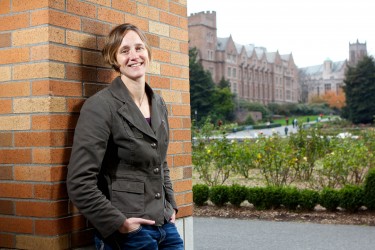
More than ever before, people—emergency responders, media, and the public—are turning to social media to communicate important information during times of crises, both natural and manmade. Whether to articulate their own whereabouts to friends and family after a disaster has occurred or to offer up help to others in need, connected crowds are wading through noise and rumors that persist online to assist in the aftermath of tragedy.
Part of the Surviving Disaster: Natural Hazards & Resilient Communities series from the UW College of the Environment, UW Alumni Association, and UW Graduate School, Kate Starbird explored this new type of “digital volunteerism” for an audience at Kane Hall on Tuesday, October 27.
An assistant professor at the College of Engineering, Starbird shared her innovative research looking at the intersection of social computing and disaster events, specifically the tools people use to connect and share information and the behaviors that those platforms enable.
Key takeaways
- Social media and connected crowds present an opportunity to gain more information about what’s going on during disaster events and, ideally, to be able to make better, faster decisions as a result of having more information available.
- Digital volunteerism emerged after a magnitude 7 earthquake hit Haiti in 2010. People from all over the world were helping from afar using online tools to amplify, route, verify, and remote operate.
- When Hurricane Irene flooded the Catskills in 2011, live blogging showed successful emergent collaboration across platforms.
- Twitter was used to talk to the media and to the remote crowd after the Oso landslide in 2014, while Facebook was leveraged by the local community.
- The volume of data that can be taken from social sites, the noise found within that content, misinformation and rumors, and unstructured data are the main challenges to utilizing information that sits at the intersection of social computing and disaster events.
Quotes that resonate
- “Everything about disasters is social. It wouldn’t be a disaster or a crises event if it didn’t affect our lives.”
- “The crowd is appropriating social media and other online tools to converge digitally, to connect and collaborate to solve problems during crisis events.”
- “Social media are becoming part of the critical infrastructure of emergency response.”
- “The existence of these tools are putting strain on traditional relationships between government, media, and members of the public. They’re opening up new opportunities, but also putting strain.”
- “Rumors are sort of a byproduct of the collective sense making process people go through when they’re trying to make sense of imperfect information in times of uncertainty and anxiety. But online dynamics can change the situation.”
- “How do we build technologies—tools, social media, but also policies and systems—to support resilience, knowing what we know about this human behavior? These aren’t just technical questions, they’re human questions.”
Related reading
- Social media becoming a tool for more than being social (The Daily)
- How social technologies and human behavior are changing the aftermath of disasters (GeekWire)
- Why Social Media Is the Front Line of Disaster Response (Mashable)
- How Social Media Is Changing Disaster Response (Scientific American)
- A Guide to Social Media Emergency Management Analytics (Humanity Road)
Upcoming Surviving Disaster lectures
11/3: Jake Wood (RSVP) |11/10: John Vidale (SOLD OUT)—stay tuned for our Q&A with the Earth and Space Sciences professor!

